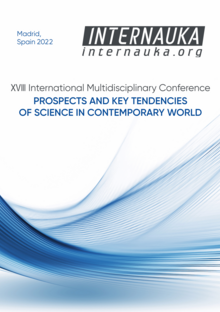IMPACT OF QUALITY CHANGE ON MILK PRODUCTION

IMPACT OF QUALITY CHANGE ON MILK PRODUCTION
Anna Krovikova
Candidate of Biological Sciences, Associate Professor Federal State Budgetary Educational Institution of Higher Education "Moscow State Academy of Veterinary Medicine and Biotechnology - MVA named after K. I. Skryabin,
Russia, Moscow
Reproduction of cattle is one of the main and most complex biological processes that determines the growth of the head and the possibility of selecting its best part. For the proper organization of breeding work, it is necessary to take into account factors affecting the reproductive function, which includes feeding and keeping cows, the organization of artificial insemination, the number of normal calving, proper rearing of young animals, the duration of the interbody period, the fertilizing ability of bulls, as well as the age of the first insemination. Moreover, with the improvement of feeding conditions and maintenance, it is possible to achieve an increase in reproductive capacity.
In the past years, dairy farming was formed mainly due to the intensification of production processes, where the main place is given to the course of enhanced milk production in the conditions of industrial technology. Accelerating the pace of formation and increasing the efficiency of dairy cattle breeding is achieved by genetic improvement of livestock, and in addition, increasing the degree and improving the quality of cow feeding, optimizing technological processes. Dairy productivity and productive longevity of cows are caused by many genetic and paratypical factors, one of which is the duration of the service period, since the reproductive and productive activities of cows are closely related.
A high level of lactation provokes the restructuring of the animal's body, the transformation of correlational relationships between different organs. First of all, milk productivity places increased demands on the reproductive system, since reproduction and lactation in mammals are methodical stages of the holistic biological process of reproduction (Perfilov A.A., 2009). Accordingly, the reproductive ability of cows directly affects the efficiency of breeding in the herd, and the service period, in turn, on reproduction and milk productivity (Kostomakhin, N., Bakai A., Lepekhina T. 2014; Sudarev N., 2008). Accordingly, reproductive capacity is an important component of dairy cattle breeding technology. Annual calving contributes to the cost-effective production of milk, and regular receipt of calves in sufficient quantity makes it possible to carry out breeding work at a high level and serves as the basis for expanded reproduction of the herd, and consequently, the economic efficiency of the industry (Samusenko L.D., 2016).
The relationship between the level of milk productivity and the reproductive ability of cows has been studied by various scientists, but contradictory results have been obtained. F.F. Lyagin in his research describes that the early age of the first mating and calving has a negative impact on subsequent milk productivity. A small interval between calving leads to a decrease in milk productivity, both for the current lactation and for subsequent ones. The higher the productivity, the longer the service and interbody periods, since in highly productive cows the restoration of the functions of the reproductive apparatus is delayed and when they are inseminated in the first and second hunts they often remain unfertilized (Prokofiev M.T., 2002).
According to V.A. Pavlov, high milk productivity, on the contrary, does not adversely affect the reproductive function of cows. He analyzed data on 206 cows of different breeds with record productivity and found that 39% of them had a service period of up to 90 days, and 8 recordists had up to 45. This indicates that fertilization of highly productive cows at an early date is possible. The scientist interprets the duration of the service period of more than 200 days not with the milk dominant, but with the disturbed organization of insemination. Further, E.P. Karmanova and A.E. Bolgov emphasize that in conditions of large-scale breeding, evaluating bulls by offspring, it is recommended to calculate correlations between the most important traits, since each producer-improver is used very intensively, and undesirable correlations can quickly spread in herds. Despite the fact that there is no consensus on the impact of milk yield on reproductive function, many researchers note that with its increase, fertility decreases (Lebedko E., 2009). That is, a set of measures aimed at increasing productivity does not have a positive effect on the reproductive ability of cows, hence the decrease in milk productivity for productive longevity (Perfilov A.A., 2009).
References:
- Kostomakhin, N., Bakai, A., Lepekhina, T. The effect of the duration of the service period on the milk productivity of cows of different genotypes / Kostomakhin, N., Bakai, A., Lepekhina, T. // Chief zootechnik - 2014 — №2 - 3-7 p.
- Lebed'ko Ye.V. Udoi pervotelok razvertyvaniya ot servis-perioda / Ye. Lebed'ko, Ye. Torikova, L. Nikiforova // Zhivotnovodstvo Rossii. - 2009. - №9. - 37-38 s.
- Perfilov, A.A., Reproductive qualities of cows depending on the level of milk productivity: abstract. dis. spec. 06.02.01 / Perfilov, A.A.: Samara State Agricultural Academy, 2009 — 19 p.
- Prokofiev, M.T. The relationship between the level of milk productivity and the manifestation of reproductive function in cows / Prokofiev, M.T. // Zootechniya — 2002 - No.10 — 22-25 p.
- Sudarev, N. Milk yield and service period are interrelated / N. Sudarev // Animal husbandry of Russia. - 2008. - No. 3. - 49-51 p.
- Samusenko, L.D., Himicheva, S.N. On the relationship of the reproductive ability of cows with their milk productivity / Samusenko, L.D., Himicheva, S.N. // Oryol State Agrarian University — 2016 - №2 — 7-11 p.
